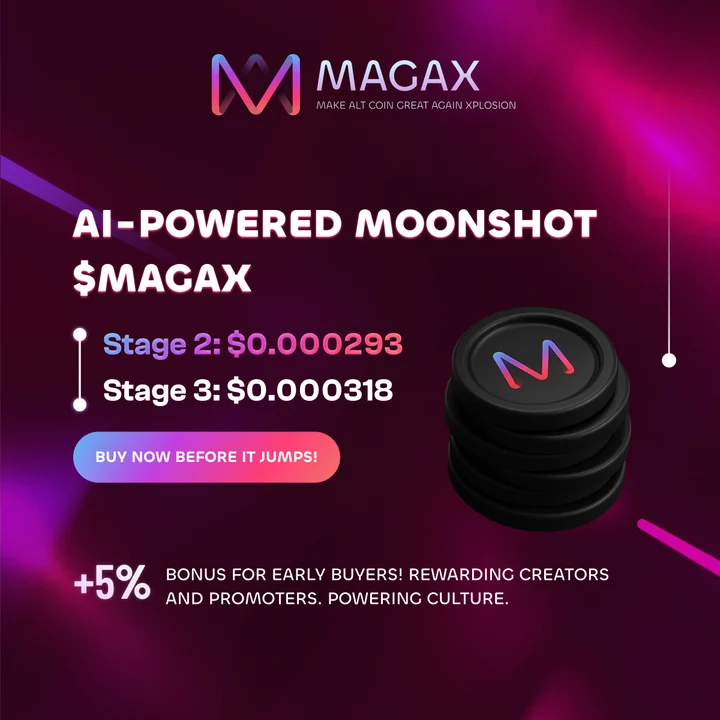Solana’s NFT Dominance Holds, But One Meme-to-Earn Presale Could Rocket 24,900%
As Solana cements its role in NFTs, retail investors eye MAGAX for asymmetric upside.
Solana has continued to dominate the NFT conversation in 2025. The chain processed $374M in NFT volume in August, maintaining its position as the second-largest blockchain for NFTs behind Ethereum. Collections like Mad Lads and Famous Fox Federation have seen steady floor prices, while newer entrants are fueling daily activity across Solana’s marketplaces.
Solana has proven it can support NFT ecosystems at scale, and developers are doubling down on NFT integrations with DeFi and gaming. Analysts say Solana’s speed and low fees remain key advantages.
Ethereum vs. Solana: The Ongoing Race
Two ecosystems battle for NFT dominance.
Ethereum remains the home of “blue-chip” NFT collections like BAYC and Pudgy Penguins, but Solana has carved out a lane with affordable minting and higher retail participation. This balance has allowed Solana to chip away at Ethereum’s dominance.
Solana has maintained more than 30% of all NFT transactions this year, a sign that the chain’s active user base is sticky. While Ethereum dominates institutional NFT plays, Solana continues to win grassroots adoption.
Solana may dominate NFTs, but MAGAX is building momentum in presales.
Retail Looks Beyond NFTs for Multipliers
Investors chase asymmetry in presales.
While NFTs continue to capture headlines, retail traders are increasingly turning to presales for bigger upside. The logic is simple: NFTs on Solana or Ethereum may hold value, but they rarely deliver multi-thousand-percent gains in a short time frame. Presales, on the other hand, have historically created life-changing ROI for those willing to take early risk.
This is where MAGAX enters the conversation. Positioned as a Meme-to-Earn presale, it’s riding the same cultural momentum that made DOGE and SHIB famous but adding AI-powered fairness to make the process sustainable.
MAGAX: Meme-to-Earn With ROI Projections That Turn Heads
AI filters, staking, and DAO governance add credibility to viral culture.
The MAGAX presale has already cleared seven figures in commitments, with its Stage 2 tokens priced at $0.000293. More than 65% of this stage is sold, and each round comes with higher pricing.
What makes MAGAX stand out is its Meme-to-Earn model, powered by Loomint AI:
- AI-Powered Trend Detection: Real-time scans of social media to spot authentic meme virality.
- Fraud-Resistant Rewards: Fake likes and engagement pods are filtered out, ensuring payouts only to genuine creators.
- Staking + DAO Roadmap: Holders earn staking bonuses now, and governance rights later.
This system addresses the biggest flaw of older meme coins: no way to reward the actual culture drivers.

Analysts Compare ROI Narratives
24,900% projections make presales impossible to ignore.
Crypto analysts at Intellectia recently compared meme presales, noting that MAGAX’s projections of up to 24,900% ROI place it in the same league as early-stage SHIB or DOGE hype cycles. Solana is winning on NFTs, but MAGAX is where retail traders are chasing outsized returns.
The Culture vs. Infrastructure Debate
Solana builds, MAGAX captures buzz.
The conversation around Solana vs. presales like MAGAX highlights a broader debate in crypto: infrastructure versus culture.
- Solana is building long-term infrastructure for NFTs, DeFi, and gaming.
- MAGAX is capturing culture, memes, and virality in real time.
Both are valuable, but one offers stability while the other offers asymmetry. Retail investors seeking high-risk, high-reward opportunities are more likely to flock to MAGAX than to established blockchains.
Don’t miss the presale momentum – join MAGAX today.
Why September Is Defining the Cycle
Presales are setting the stage for 2025’s bull run.
September has been packed with presale stories: Little Pepe raised more than $26M, while BullZilla caught headlines with its influencer-backed hype. Against that backdrop, MAGAX is carving out its lane as the meme-to-earn presale with real AI utility.
Meanwhile, Solana continues to secure its dominance in NFTs — but for investors chasing 24,900% projections, presales like MAGAX are far more attractive.
The Takeaway: NFTs Are Strong, Presales Are Stronger
Infrastructure and culture can both thrive, but retail wants multipliers.
Solana’s NFT dominance proves the chain is a major force in Web3. But for traders seeking asymmetric upside, MAGAX offers something different: a way to ride meme virality with fairness and transparency built in.
If Solana is about building the rails of Web3, MAGAX is about fueling the trains that run on those rails — fast, viral, and community-driven.
Explore the MAGAX presale today and secure your position before the next stage price increase.
The post Solana’s NFT Dominance Holds, But One Meme-to-Earn Presale Could Rocket 24,900% appeared first on Blockonomi.
You May Also Like

Here’s Why Mantle (MNT) Price Is Pumping Today

Cashing In On University Patents Means Giving Up On Our Innovation Future
